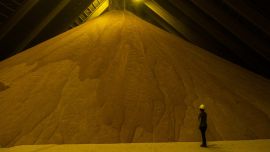Marcelo Cervigni, like thousands of Argentine farmers, is getting ready for the main event of the year: the soybean harvest. The timing couldn’t be better for President Javier Milei, who needs the billions of dollars that shipments fetch to offset the country’s spiralling foreign-exchange deficit.
But there’s a problem. Cervigni and his peers plan to take it slowly, betting that prices — beaten down by Donald Trump’s global trade war — will rally later in the year, potentially rewarding those who sell their soybeans then. “We won’t rush,” said Cervigni, who farms 16,800 acres in San Antonio de Areco, a rural town about 90 minutes from Buenos Aires.
Despite Milei’s ambitious plans to transform Argentina to a market-led economy, some things just don’t change. Like his predecessors, the President is depending on the soy harvest to manage one of the word’s most volatile currencies.
And there are clear signs the peso is slipping away from Milei. The gap between the government-controlled exchange rate and the “blue-chip swap” rate influenced by traders has widened to more than 25 percent, the most since October, according to data compiled by Bloomberg.
Argentina’s farmers collect beans from their fields, then truck them to global trading houses, which process them into meal for livestock feeds and soy oil for cooking and biofuels to ship around the world. The country is the number one exporter of both products globally.
Traders — who have to convert 80 percent of their foreign sales into local currency — have up to 30 days from whenever they sell a shipment to turn their dollars into pesos, at the official rate. Those requirements are part of Argentina’s web of controls on what companies and individuals can do with hard currency holdings, with the aim of protecting the peso.
The soy dollars will, yet again, provide crucial ammunition, amounting to the lion’s share of around US$30 billion of crops that Argentina is forecast to export this year. Those revenues may roll in at a slower clip than Milei needs as farmers — many of them grappling with the worst profit margins since the 1990s — wait for better prices.
Forward sales of the 2025 soy harvest are the most cautious in a decade, according to the board of trade in Rosario, Argentina’s grains-shipping hub, with just 17 percent of estimated supplies for the season traded so far, which is seven percentage points below the historic average, analysts wrote in an April 4 report.
“When prices are falling, farmer selling slows,” said Francisco Perkins, who grows crops across over 13,340 acres in prime farmland in western Buenos Aires province.
Fellow farmer Cervigni said brokers have offered him just US$295 for every metric ton of soy harvested, below the US$310 it cost to plant and below what he calls the “pain price,” or breakeven.
“Harvest dollars will be a bálsamo — a relief — for the government, but the magnitude isn’t clear,” said Fernando Losada, an economist at Oppenheimer in New York. Argentina will also receive less from its growing oil exports as global energy prices have fallen, he said.
For the time being, other sources of cash could augment those dollar flows from commodity sales, including additional funds from the International Monetary Fund, the World Bank and the Inter-American Development Bank. Between the soy proceeds, the IMF and the banks, Argentina could receive more than US$20 billion in hard currency through June, according to estimates by local brokers TPCG and Max Capital.
The government expects an US$8-billion early disbursement from the IMF as well as US$3 billion to US$5 billion in loans from other lenders, offering a short-term boost to Central Bank reserves. Reserves fell below US$25 billion this week, their lowest level in 15 months. IMF staff agreed to a new financing programme for Argentina on Tuesday, with the executive board set for a final vote Friday.
But, the money will come with strings attached, meaning Argentina likely won’t be able to use all of it to intervene in the foreign-exchange market. The IMF is also expected to set targets for the Central Bank to grow its reserves. “Everything suggests that the government is going to be forced into greater exchange-rate flexibility,” Losada said.
For farmers, the timing and volume of soybean sales depend on commodity prices, access to their fields during heavy rains, and — potentially the hardest to come by — confidence in Milei’s exchange rate strategy.
“As soon as there is clarity about the exchange rate regime, the grain sales will be numerous and they will come all at once. May and June will see a lot of dollars on offer,” said Juan Manuel Pazos, chief economist at TPCG Valores. He expects sales of about US$10 billion before June 30.
A temporary tax cut triggered strong sales of the 2024 crop earlier this year, but activity linked to the 2025 harvest has been more subdued. “Sales are progressing steadily, mostly linked to specific financial needs or occasional price spikes,” said Ariel Tejera, an analyst at broker Grassi SA.
Perkins, the farmer from western Buenos Aires, said now isn’t the time to sell. “It’s a time to sit still. Trading when there’s a lot of noise in the market isn’t usually a good strategy,” he said.
by Ignacio Olivera Doll & Jonathan Gilbert, Bloomberg






















Comments